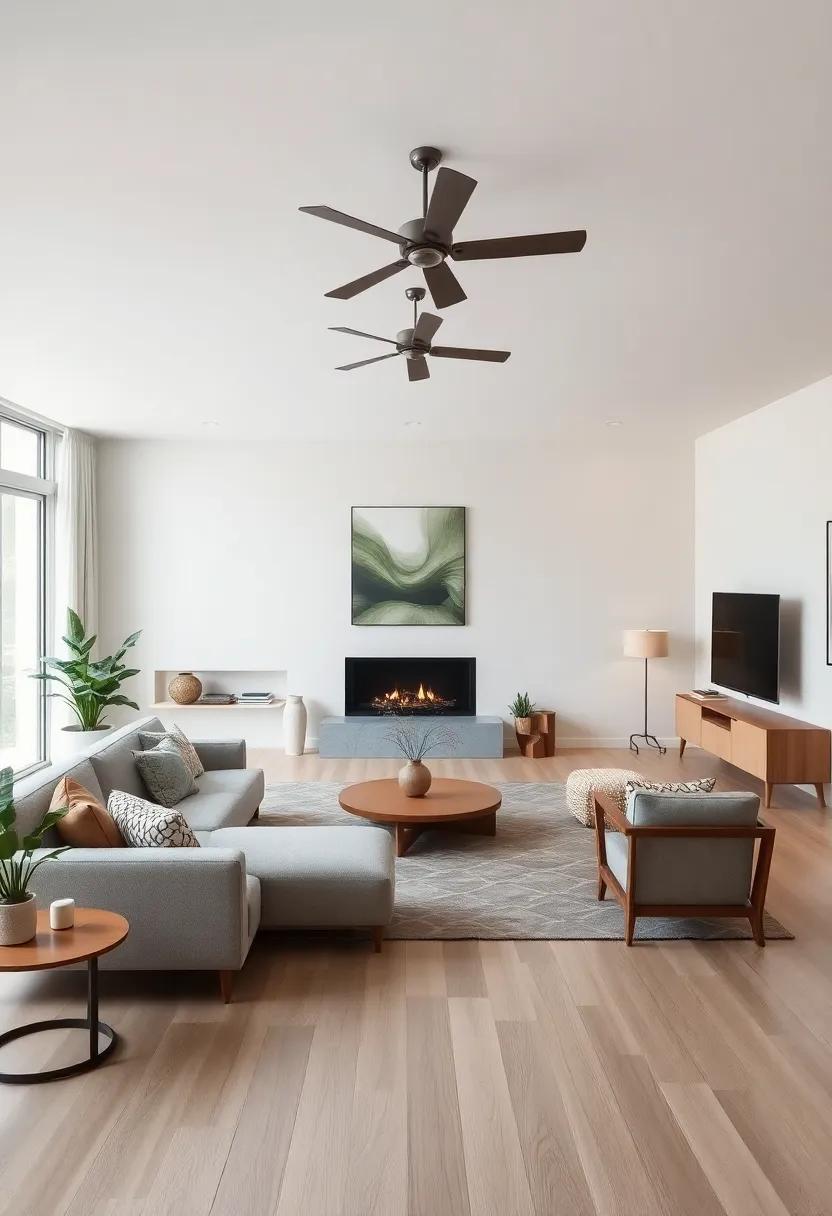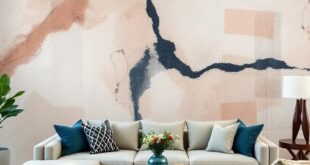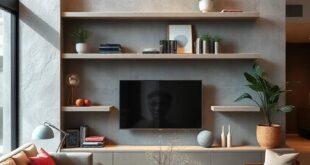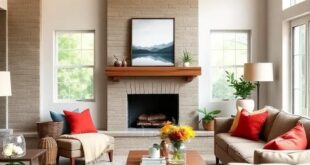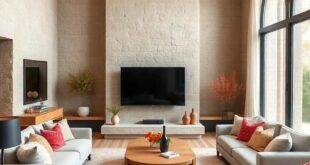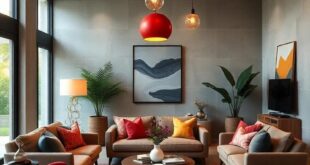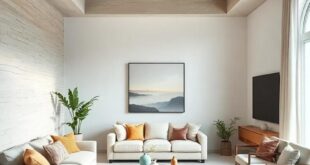In the realm of interior design, few styles have made as lasting an impression as mid-century modern. Characterized by its clean lines,organic forms,and an emphasis on functionality,this aesthetic celebrates simplicity and an effortless connection between indoor and outdoor spaces.As contemporary living trends increasingly embrace open floor plans, the challenge often lies in infusing personality and warmth into these expansive areas. In this article, we will explore the art of designing a mid-century living room that not only honors the principles of this timeless style but also maximizes the potential of an open layout. From selecting the perfect furnishings to incorporating thoughtful décor,join us on a journey to create a harmonious and inviting space that truly embodies the spirit of mid-century design while adapting to the fluidity of modern living.
Embracing Natural Light in a Mid-Century open Floor Plan Living Room
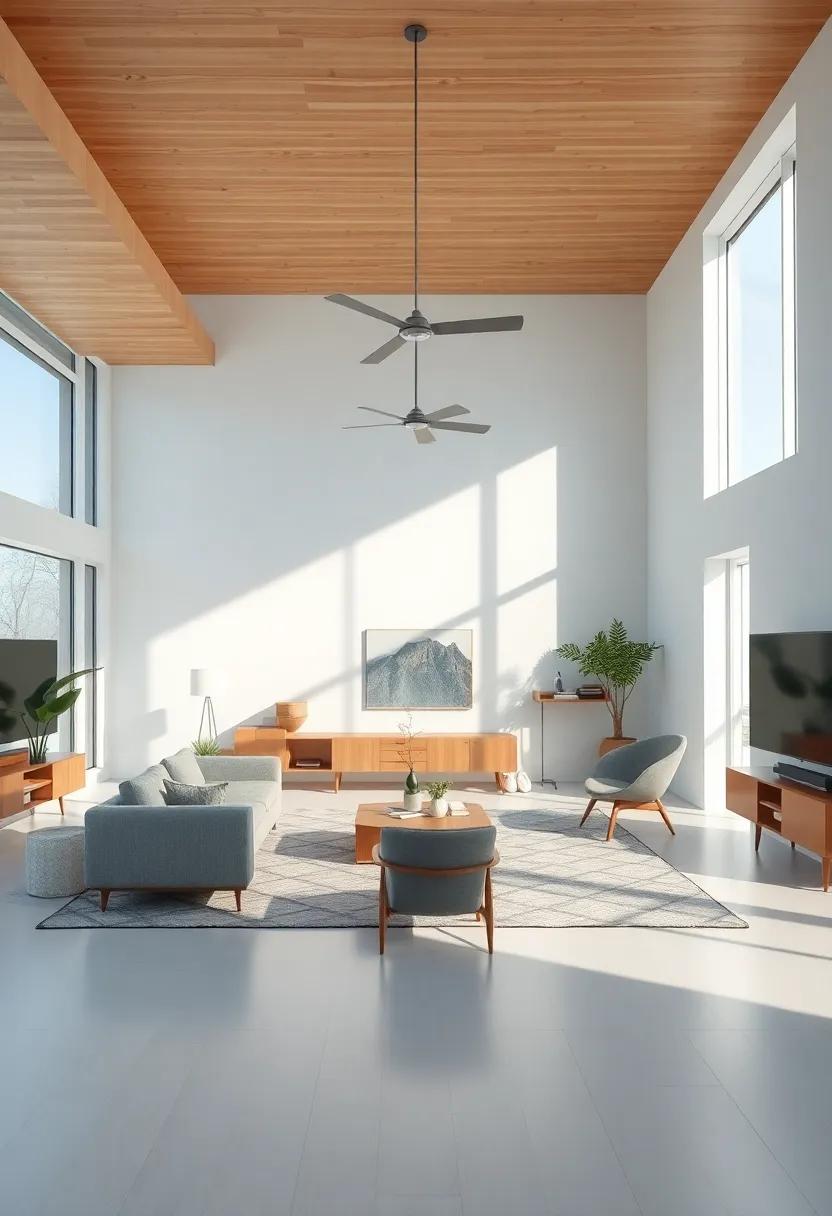
In the heart of mid-century architecture lies a festivity of open space, where natural light dances across every surface. Large windows serve as portals to the outside world, flooding the living room with sunlight and creating an inviting atmosphere. To complement this illumination, consider incorporating reflective surfaces and light-colored furnishings, which can enhance the brightness and give the space a more airy feel. Elements such as:
- Mirrored coffee tables
- Glossy wall finishes
- Glass decor
can act to amplify sunlight and maintain the room’s vibrant energy. Additionally, strategically placing plants near windows not only adds a pop of color and life but also connects the indoors with the natural world outside. Choosing species that thrive in bright light, such as:
- Fiddle Leaf Fig
- Rubber Plant
- Snake Plant
can enhance this effect, creating a serene environment reminiscent of mid-century modern ideals.
Balancing Color Palettes for a Cohesive Mid-Century Aesthetic

Creating a cohesive color palette is essential when designing a mid-century living room,especially in an open floor plan where multiple areas are visible at once. To achieve this, consider the following color combinations that pay homage to the iconic designs of the era:
- Rich Earth tones: Deep olives, burnt sienna, and muted auburns can form a warm backdrop.
- bold Accent Colors: Complement earth tones with splashes of mustard yellow or teal for visual interest.
- Neutral Base: Incorporate whites or creams as a base color to provide balance and enhance light.
Utilizing these color combinations facilitates a seamless transition across spaces,promoting unity throughout the room. Consider creating a color swatch board to visualize how your chosen shades interact; this step is crucial in refining your aesthetic before committing to paint or furniture selections. An example of how these colors might be arranged within your space is outlined in the table below, demonstrating potential elements and their corresponding colors:
| Element | Color suggestion |
|---|---|
| Sofa | Burnt sienna |
| Accent Chairs | Teal |
| Rug | Muted olive |
| Wall Color | Cream |
| Throw Pillows | Mustard yellow |
Incorporating Iconic Mid-Century Furniture Pieces for Maximum Flair
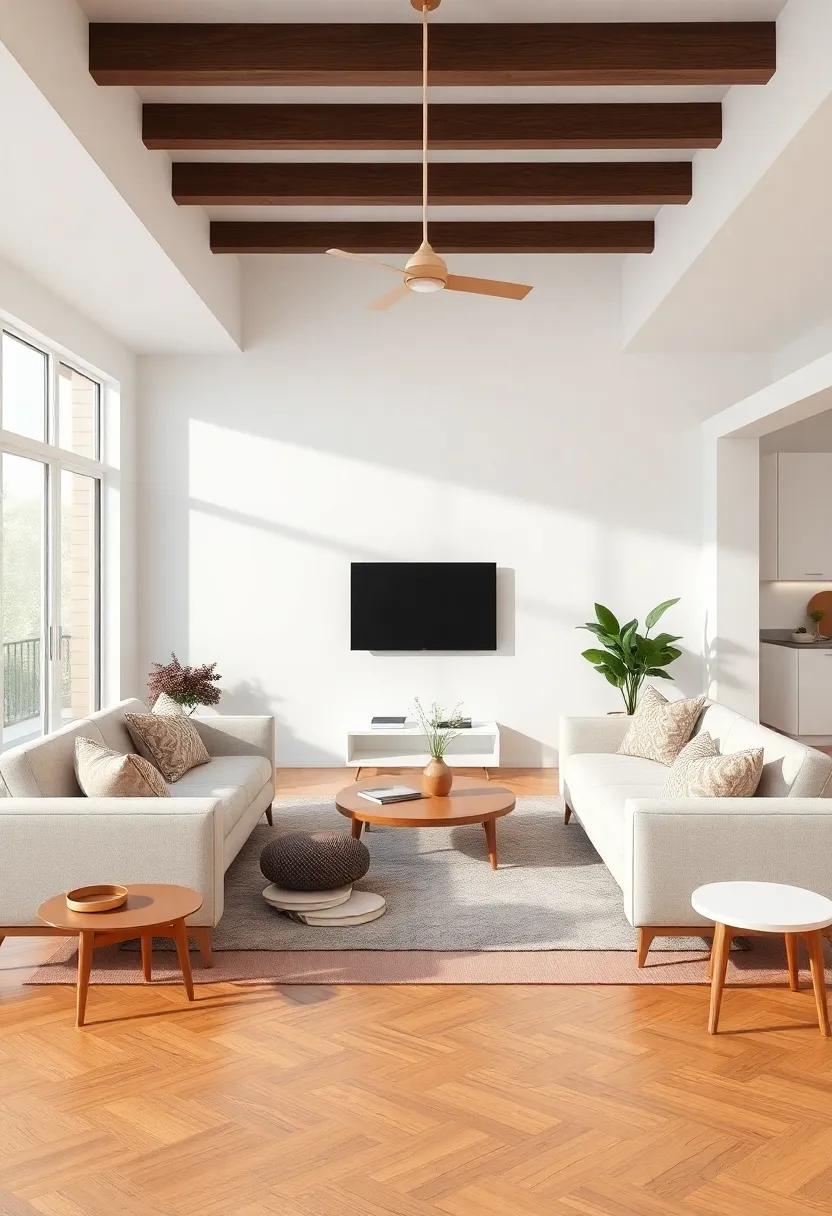
To transform your open-concept living area, consider showcasing iconic mid-century furniture pieces that not only serve as functional essentials but also as artistic statements. A well-placed Eames lounge chair can become an inviting focal point, offering comfort without compromising on style. Pair it with a sleek Mid-Century Modern coffee table, crafted from rich wood and accentuated with clean lines, creating a harmonious visual balance. additionally, opt for a vibrant area rug that complements the palette of your space, tying the design elements together seamlessly.
Incorporating various textures and colors is key to achieving that coveted mid-century vibe. Consider these standout pieces:
- teak Sideboard: Perfect for storage while adding a touch of elegance.
- Accent Chairs: Choose a set in bold colors to make a statement.
- Statement Lighting: A graphic pendant lamp can elevate the room’s ambiance.
Utilize a thoughtful arrangement that encourages conversation and flow, while also allowing each piece to shine. with mid-century furniture, a minimalist approach can often yield maximum impact, creating an inviting environment that feels both spacious and curated.
Creating Flow and Functionality with Furniture Arrangement
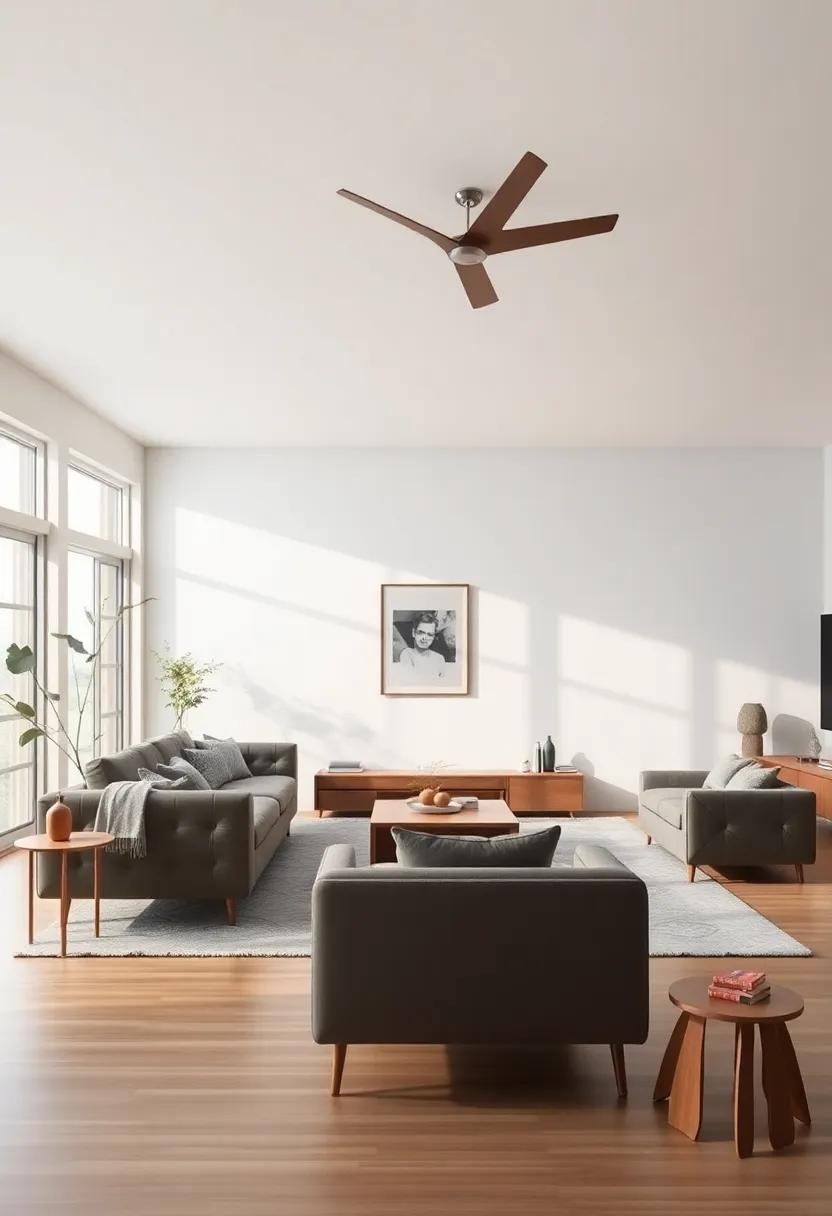
Choosing the right arrangement of furniture in your mid-century living room can substantially enhance the flow and functionality of your open floor plan. Begin by considering the natural traffic patterns in the space. Placing larger pieces such as a sofa along a wall allows for easy movement and creates an inviting focal point. Use geometrically shaped tables, like mid-century coffee tables, to add visual interest while ensuring that pathways remain clear. To promote conversation, position seating options like lounge chairs or sofas at angles that encourage interaction, avoiding the trap of having furniture pushed against walls, which can create a disjointed atmosphere.
When curating your furniture layout, think about layering textures and styles to create a cohesive yet dynamic environment. Incorporate elements such as vintage rugs or textile throws to soften the look while adding warmth. Consider a harmonious color palette, where furniture pieces complement the walls and accents of the room. A well-placed console table or open shelving can serve both decorative and practical purposes, providing space for personal items while defining zones within the large area. Below is a simple table to illustrate effective furniture groupings:
| Furniture Type | Placement | Purpose |
|---|---|---|
| Sofa | Against a wall or positioned to face focal point | Central gathering place |
| Lounge Chairs | At a slight angle to foster conversation | Additional seating |
| Console Table | Behind the sofa or in the entryway | Defines space & storage |
| Coffee Table | Centered between seating | Functional and decorative |
integrating Natural Elements for a Warm Mid-Century Vibe
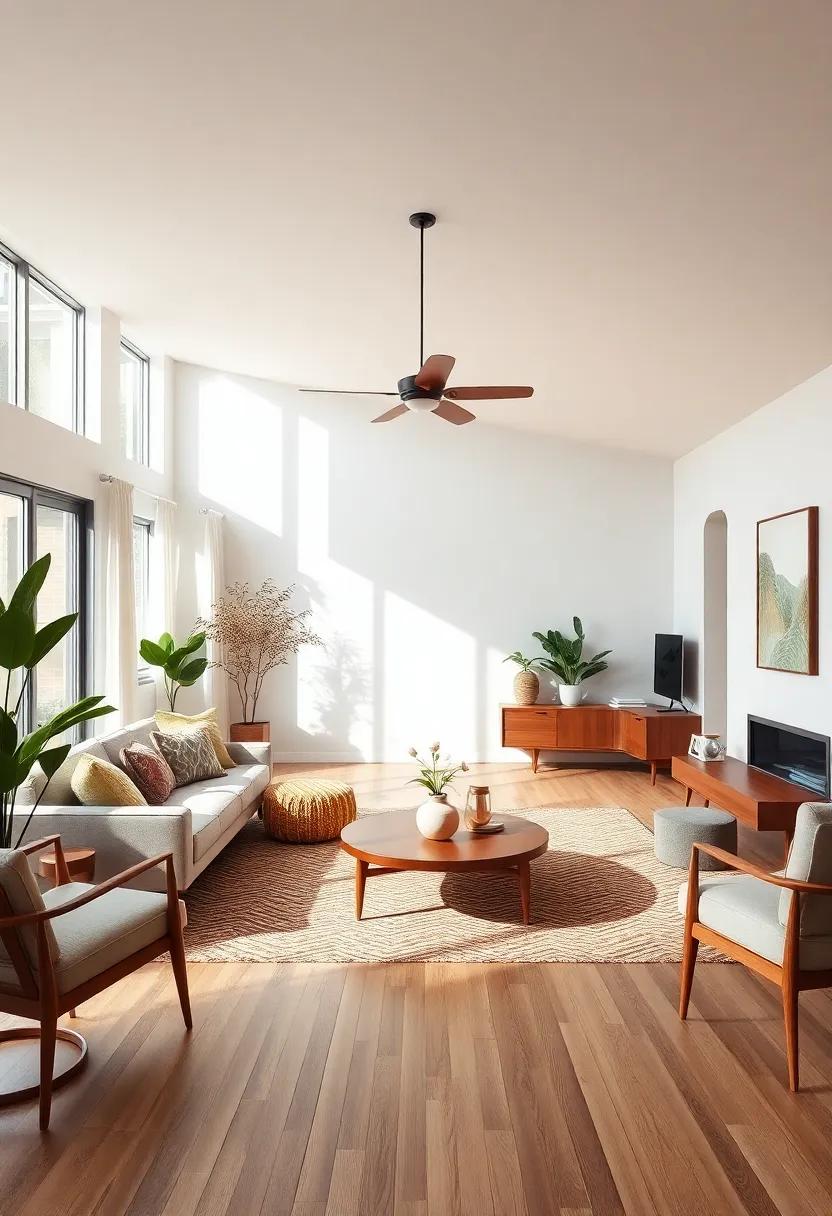
To infuse your mid-century living room with warmth, consider integrating natural elements that resonate with the organic aesthetic of the era. Wood, in its various forms, should be the star of your design. Opt for sleek walnut coffee tables or cedar bookshelves that showcase rich grains and a lovely patina. Pair these with vibrant indoor plants, such as fiddle leaf figs or snake plants, which not only elevate your decor but also purify the air, enhancing the overall ambiance. A woven jute rug can ground the space while adding texture, seamlessly blending with the iconic styled furnishings.
Textures play a crucial role in achieving that desired inviting atmosphere.Incorporate natural fabrics like cotton, linen, and wool in throw pillows or curtains to bring a soft touch to your design. A carefully curated selection of decorative objects—think ceramic vases and artisanal sculptures—can bring personality and warmth to your open floor plan.Consider the following elements to enhance your mid-century space:
- Warm wood Tones: Use furniture made of rich,warm woods.
- Lush Greenery: Add potted plants for a refreshing touch.
- Textured Fabrics: incorporate cushions and throws in soft natural fibers.
- Artistic Accents: Feature handmade pottery or unique artworks.
Stylish Way of Adding Texture with Textiles and Accessories
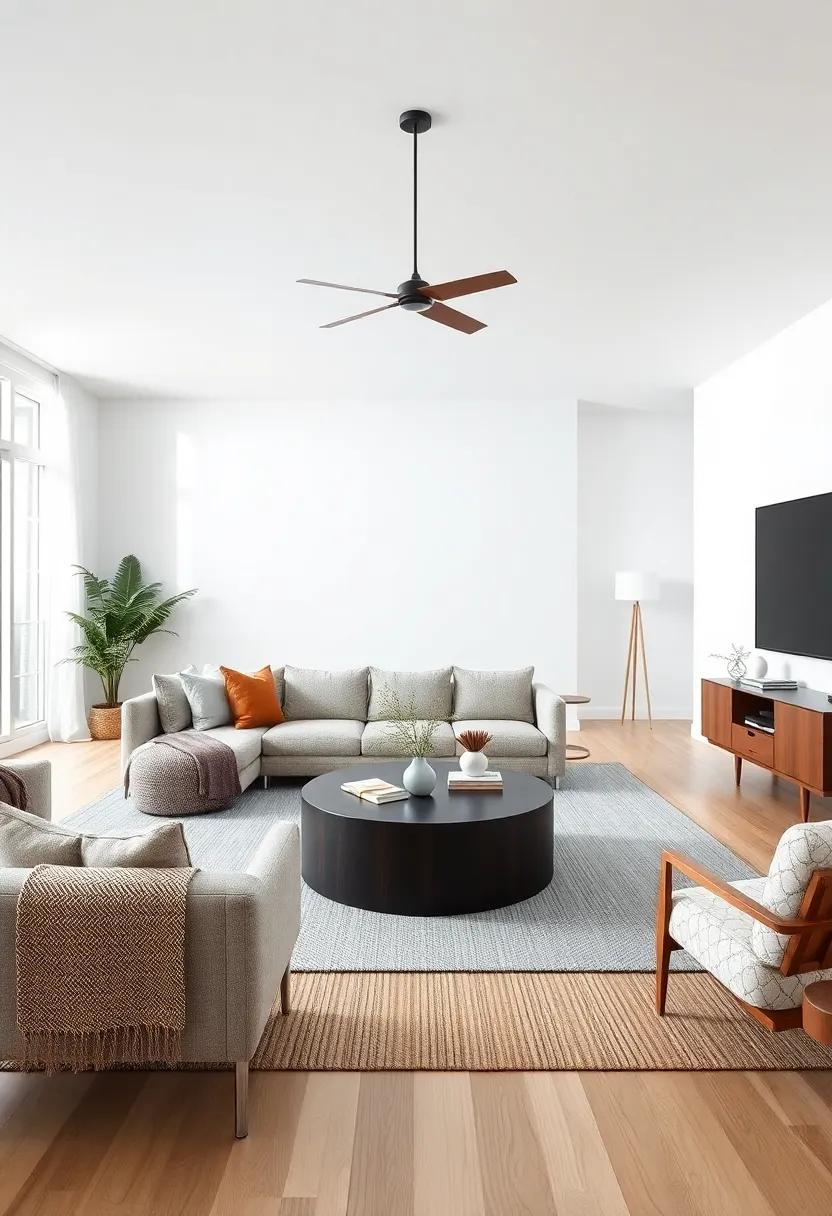
Incorporating textiles and accessories is a transformative approach to enhance the tactile quality of your space. Think beyond conventional decor and embrace elements that evoke warmth and personality. Utilize plush throw pillows in varied shapes and patterns, adding a playful visual appeal while ensuring comfort for guests. Layering textured rugs,like jute or shag,can anchor the seating area and create a cozy atmosphere,inviting more interaction in a room configured for openness. Choose drapes in lightweight fabrics that gently filter light,playing with the interplay of soft hues and shadows throughout the day.
Accessories play an essential role in weaving texture into the narrative of your living room. Opt for decorative throws made from chunky knit or woven fabric draped over sofas for an inviting touch. Incorporating artisanal ceramics and handcrafted wooden pieces as centerpieces can bring uniqueness and tactile interest. Don’t overlook plants, as their varied foliage and earthy pots introduce natural texture, infusing life into the atmosphere. For a balanced look, create a harmonious mix by strategically arranging items of different heights and materials on shelves to ensure visual depth while maintaining the mid-century aesthetic.
Showcasing Art and Decor That Reflects Mid-Century Modernism
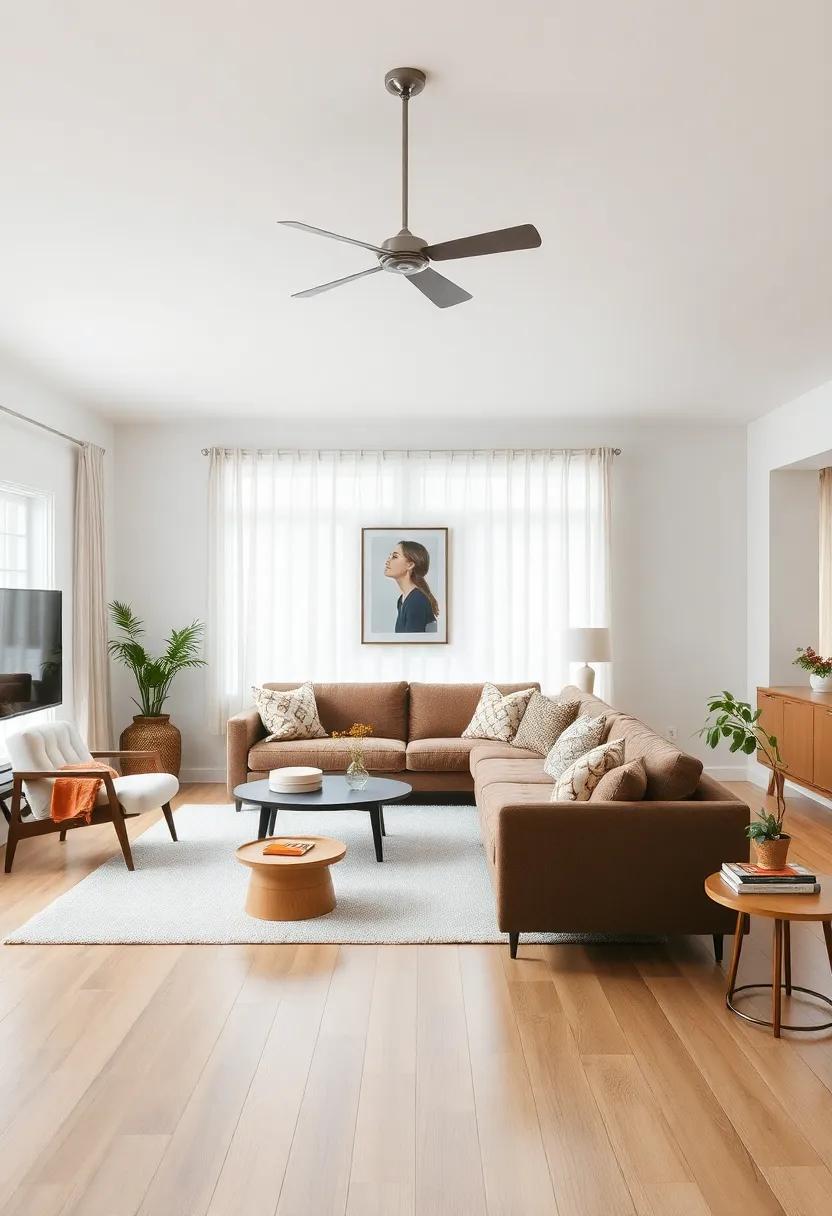
In designing a mid-century living room, the art and decor you choose play a pivotal role in infusing the space with character and authenticity. Mid-century modernism is characterized by its clean lines, organic forms, and a harmonious blend of functionality and artistic expression. Consider incorporating bold geometric patterns and warm hues to create a visual dialog that complements the openness of your floor plan. Here are a few decor ideas to enhance your mid-century aesthetic:
- Abstract art prints: Choose large-scale pieces that echo the vibrant colors and forms of the era.
- Statement Sculptures: Look for pieces that are both artistic and conversational, perhaps crafted from wood or metal.
- Textile Accents: Incorporate rugs, cushions, and throws that feature iconic patterns, such as starbursts or chevrons, to add warmth and texture.
Furniture selection is another essential aspect of creating a cohesive mid-century modern space. Opt for pieces that boast tapered legs, smooth surfaces, and an open appearance to maintain the fluidity of your design. The right furnishings will not only serve practical purposes but will also embody the era’s spirit. Consider this simple guide when choosing your key items:
| Furniture | Material | Color Palette |
|---|---|---|
| Sectional Sofa | Leather or textured Fabric | Earthy Tones or Jewel shades |
| Cocktail Table | Wood or Glass | Natural Wood Finish or transparent |
| accent Chairs | Upholstered with Wooden Frames | Bright or Muted Colors |
Merging Indoor and Outdoor Spaces for a Seamless Transition
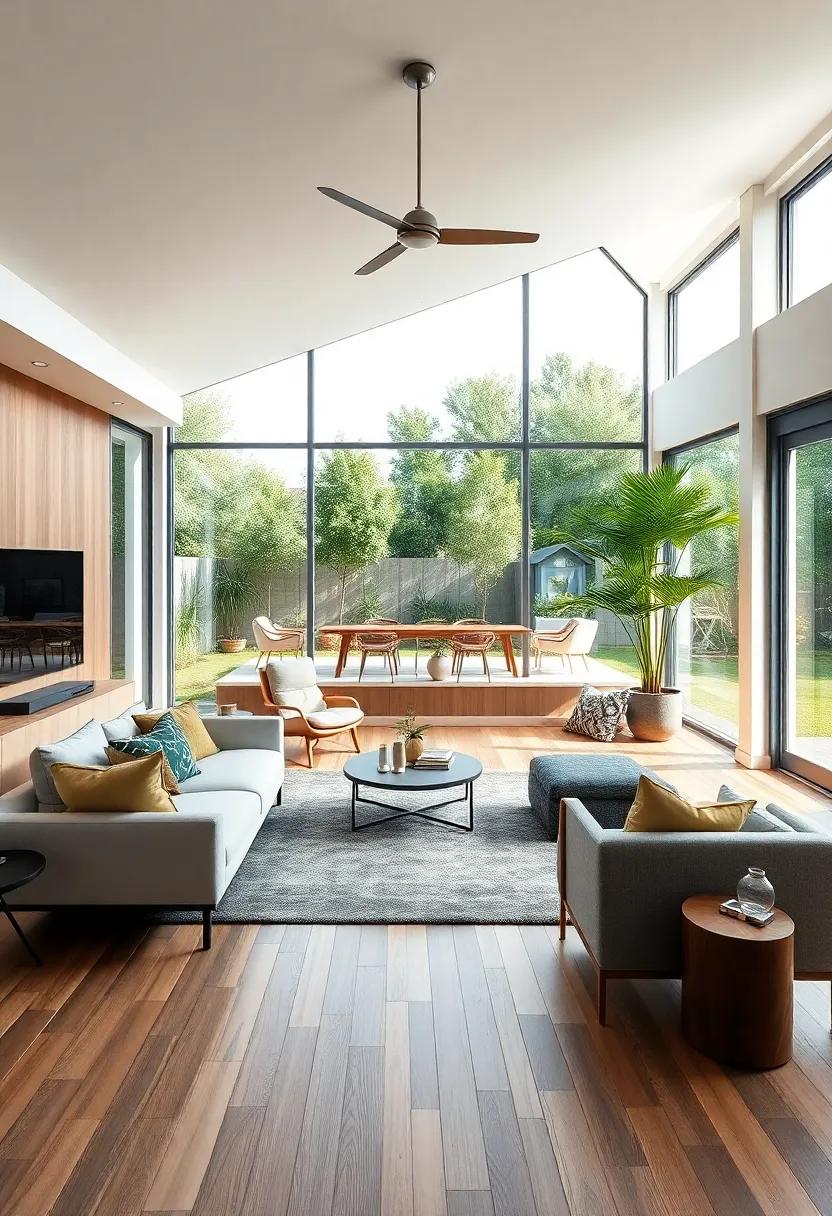
To achieve a fluid connection between indoor and outdoor areas, consider using oversized glass doors that can seamlessly slide open or fold away, inviting nature right into the heart of your living space. Opt for a neutral color palette that extends from the interior to the exterior, enhancing the sense of unity. This approach allows the natural surroundings to become an extension of your living room, blending landscapes into your lifestyle. to further enrich this atmosphere, introduce indoor plants that mirror outdoor greenery, creating visual continuity and a vibrant aura.
Textured materials are vital in bridging the gap between the two domains. Use natural wood for furniture and flooring to evoke a cozy, rustic feel, while stone elements can provide a grounding contrast. Incorporating a comfortable seating arrangement that allows for a view of outdoor spaces adds depth to the design, making the transition more inviting. Consider an outdoor terrace or patio area outfitted with similar decor themes, ensuring that:
- Furniture styles match across the spaces
- Color schemes are complementary
- Lighting fixtures harmonize
| Feature | Indoor | Outdoor |
|---|---|---|
| Flooring | Hardwood or laminate | Composite decking or stone |
| Furniture | Sofas and chairs | Weather-resistant seating |
| Plants | Potted indoor plants | Garden beds or planters |
Choosing the Right Area Rugs to Define Zones in Open Spaces
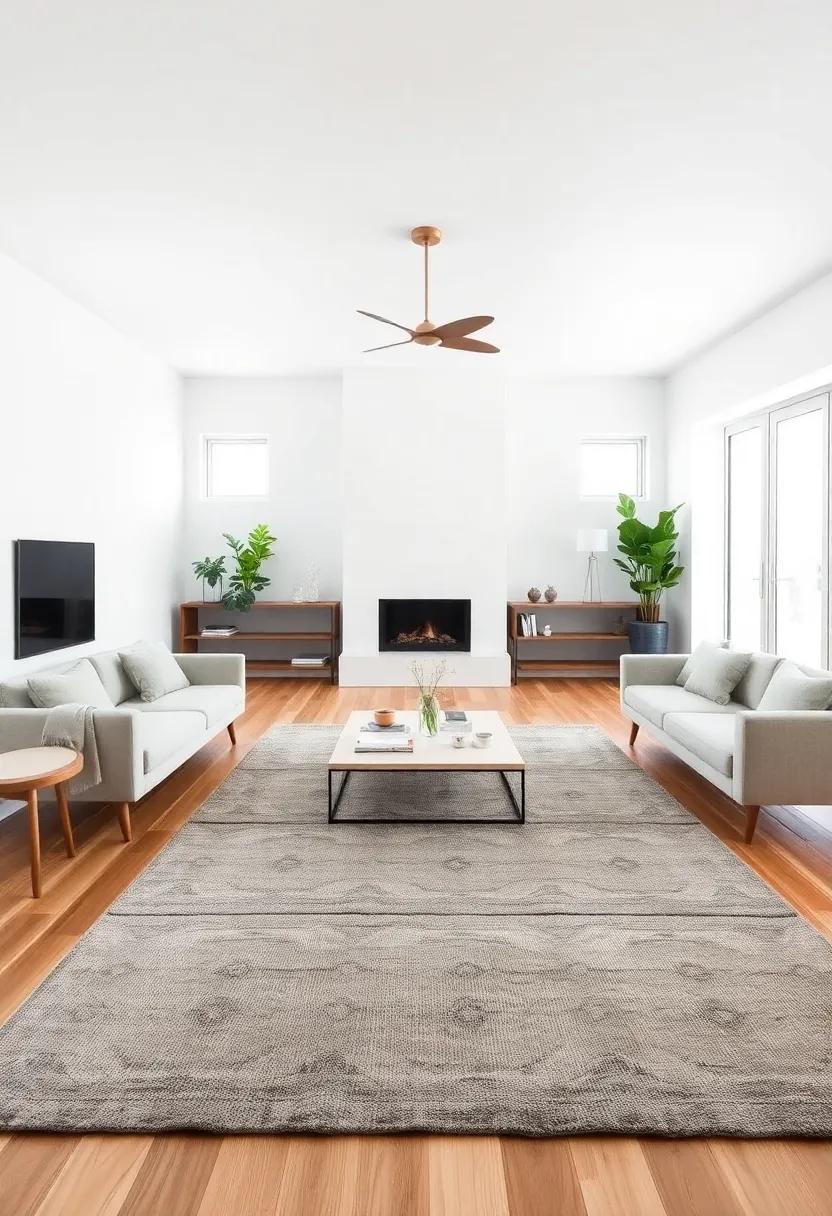
When navigating the expansiveness of an open floor plan, area rugs serve as an essential tool for establishing distinct zones that enhance both functionality and aesthetics. By choosing rugs that complement the mid-century style, you can tie together various areas without sacrificing visual harmony. Consider the following factors to ensure your selections are spot-on:
- Size Matters: pick a rug that is appropriately sized to anchor the space; ideally, the front legs of furniture should sit on the rug.
- Color Palette: Aim for colors that resonate with your existing decor to create a cohesive look, yet allow for contrast to delineate spaces.
- Texture Tactics: Utilize different textures to define areas; a plush rug can denote a cozy reading nook while a flat-weave design might suit a dining area.
An effective way to visualize how area rugs will function in your open floor plan is by creating a simple layout table. Here’s a concise example to illustrate different zones you might consider:
| Zone | Suggested Rug Style | Placement Tips |
|---|---|---|
| Living Area | Geometric Pattern | Center under coffee table with furniture legs on the rug |
| dining Area | Natural Fiber | Ensure at least 24 inches of rug extend beyond the table edges |
| Workspace | Solid Color | Position to define the work area, allowing for chair movement |
Exploring Vintage Lighting Options for Authentic Mid-Century Charm
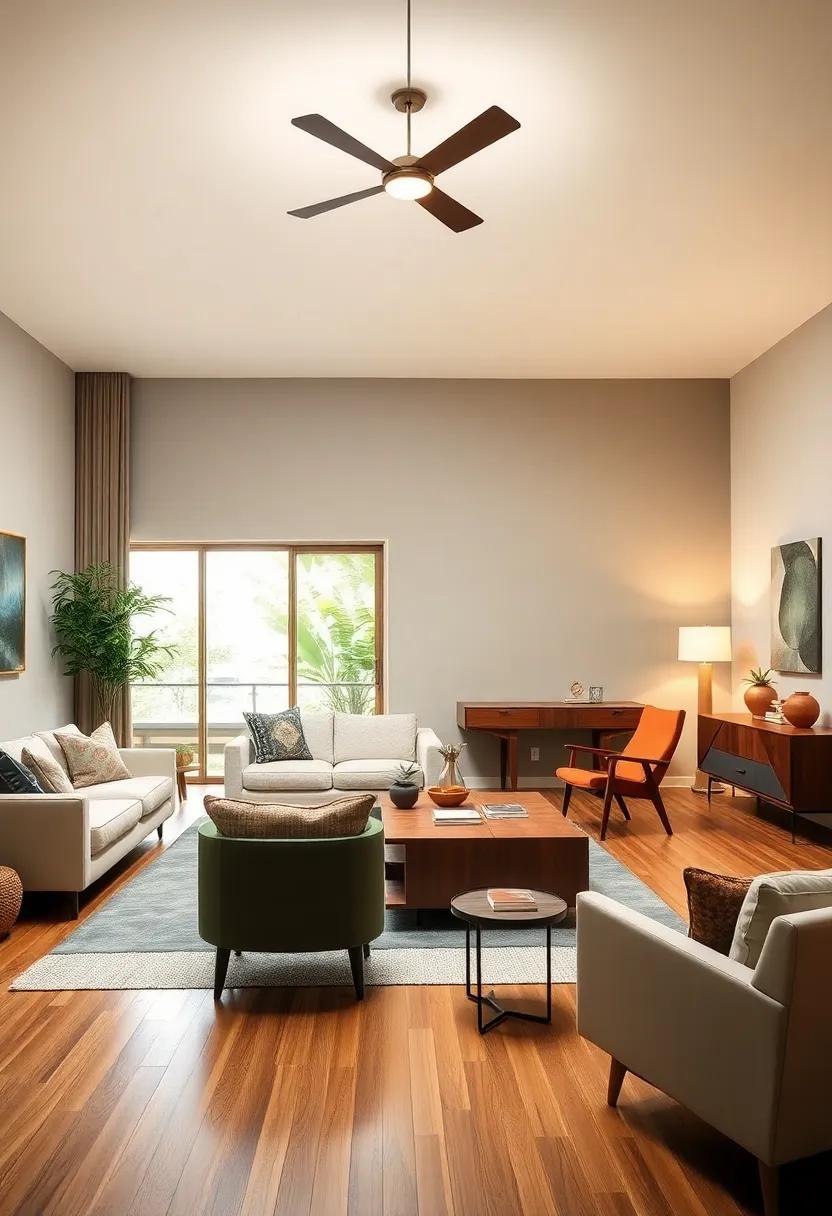
When creating a living room that reflects the quintessential mid-century aesthetic, the right lighting serves as both a functional necessity and a pivotal design element.vintage lighting fixtures—ranging from sleek floor lamps to iconic pendant lights—can significantly contribute to the overall ambiance. Consider incorporating organic shapes and warm metals like brass or copper, which harmonize beautifully with the earthy tones typical of mid-century décor. Some popular choices include:
- Arc Floor Lamps: Their elegant curves offer a sculptural quality that defines a space.
- Starburst Chandeliers: A hallmark of mid-century design, providing a striking visual centerpiece.
- Table Lamps with Bold Shades: Use geometric patterns to add visual interest while enhancing the room’s charm.
To further enhance your vintage lighting experience, consider the layering of light from various sources, which can create inviting pools of illumination throughout your space. Dimmer switches can also be invaluable in allowing flexibility in mood,transitioning from bright and lively during the day to soft and cozy in the evening. Take a look at this simple guide for an illustrative reference:
| Lighting Type | Best For |
|---|---|
| Ceiling Fixtures | Central illumination for large spaces |
| Floor Lamps | Creating height variation and focused light |
| Wall Sconces | Accent features and adding depth |
Strategic Use of Mirrors to Enhance Space and light
Incorporating mirrors into a mid-century living room can transform the atmosphere by amplifying both space and light. Strategically placed, mirrors can create an illusion of depth, allowing small areas to feel significantly larger. Consider the following placements to maximize their effectiveness:
- Opposite Windows: Position mirrors directly across from windows to reflect natural light and enhance brightness.
- Accent Walls: Utilize large, framed mirrors as focal points, breaking up wall space while still reflecting the room’s design.
- Above Furniture: Hang mirrors above key pieces, such as sofas or consoles, to create a sense of height and draw the eye upward.
Combining mirrored surfaces with othre design elements can further enrich your space. Choose finishes that complement your mid-century decor, whether it’s sleek brass frames or geometric patterns. Below is a simple guide to integrate different styles:
| Mirror Style | Best Pairing |
|---|---|
| Sleek Round Mirrors | Rounded furniture or fixtures |
| Framed Rectangular Mirrors | Straight-line sofas or coffee tables |
| Clustered mirrors | Eclectic decor items |
Designing a Feature Wall That Captivates and Inspires
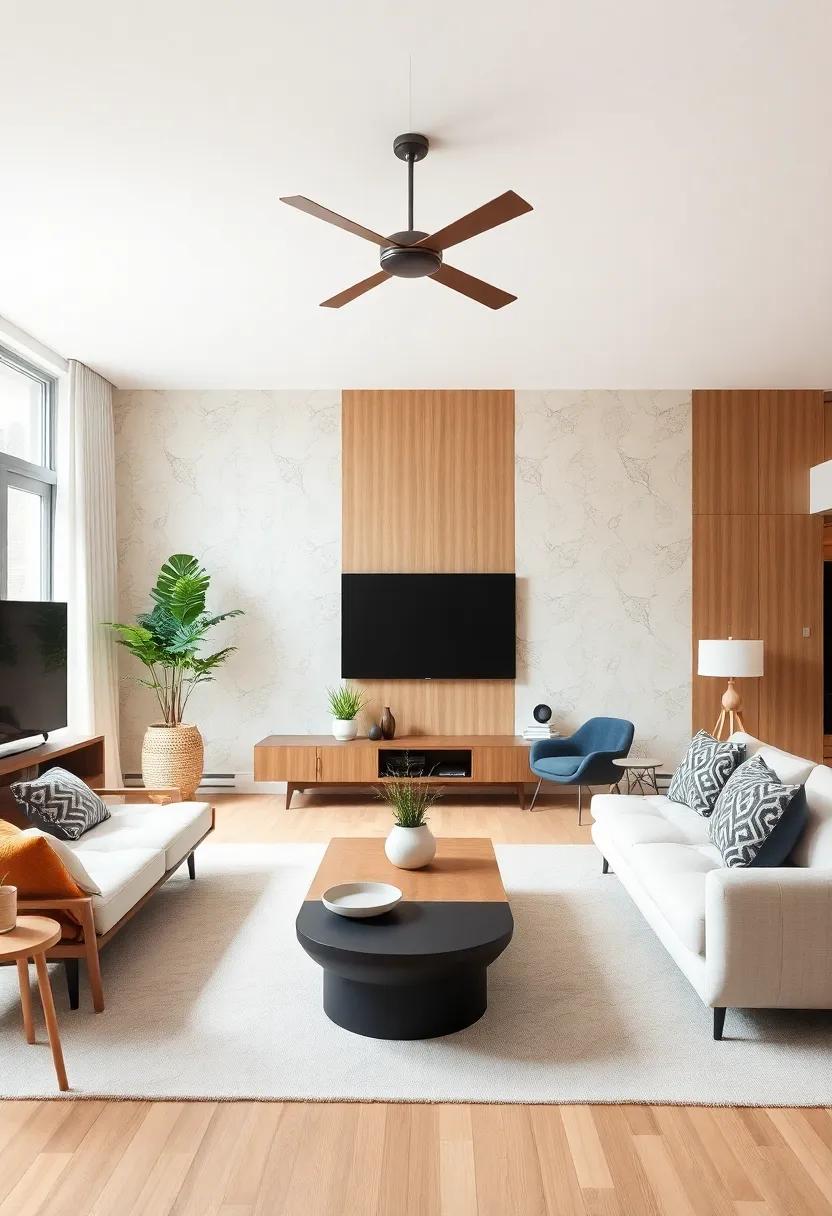
Creating a captivating feature wall is about more than just aesthetics; it’s a focal point that can harmonize the entire living space.Start by selecting a color palette that complements the mid-century elements of your room. Consider using earthy tones such as olive green, mustard yellow, or terracotta, which evoke the nostalgia of mid-century design while allowing natural light to breathe life into the space. Layer textures with patterned wallpaper, wooden panels, or even a gallery of framed art that celebrates the era. Accessories, like unique floating shelves or modern sconces, can further enhance the wall, providing both functionality and style.
When planning your feature wall, think about the scale and proportion of your decor. Large-scale art pieces can create an immediate impact, while smaller items can bring a sense of intimacy and character. Consider using a mix of shapes and materials to keep it visually engaging. To help visualize your ideas, use a simple layout:
| Element | Description |
|---|---|
| Artwork | Large canvas pieces or framed prints reflect mid-century motifs. |
| Color Scheme | Neutral base with pops of bold color to create contrast. |
| Textures | Incorporate wood, fabric, and metal for a multi-dimensional look. |
By focusing on these elements,you will create a well-rounded feature wall that not only captivates but also inspires creativity in your open floor plan living room.
Functional Yet Stylish Storage Solutions for a Clean Aesthetic
when it comes to achieving a clean, minimalist aesthetic in a mid-century living room, storage solutions that prioritize both functionality and style are crucial. Opt for sleek furniture pieces that blend seamlessly into the overall design while providing practical storage options. Built-in shelves can showcase decorative items and books without overwhelming the space, while hidden storage compartments hidden in ottomans or coffee tables keep clutter at bay. This not only maintains the uncluttered look but also enhances the character of your space with vintage-inspired pieces that speak to mid-century aesthetics.
Consider utilizing multi-purpose furniture made from natural materials, such as teak or walnut, to harmonize with the mid-century theme. Look for items like a storage bench or a stylish console table that double as storage space.To further enhance the visual appeal, consider a color palette that embraces soft earth tones and rich hues, creating a warm, inviting environment.Implementing tasteful decorative baskets or chic boxes can add a touch of personality while serving as practical organizers, helping you achieve that coveted balance between style and utility.
Curating an Eclectic Mix of Accessories for personal Touch
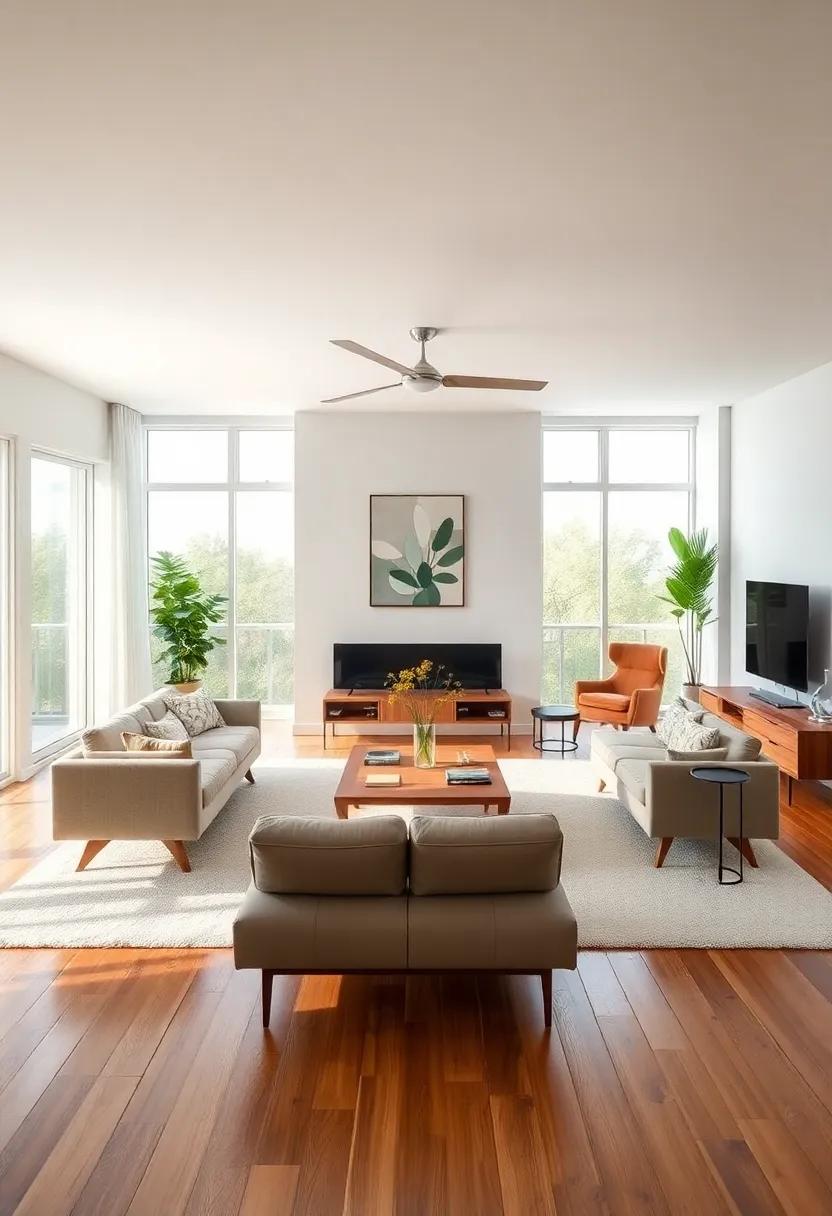
Accessorizing a mid-century living room can breathe life into your space and reflect your unique personality.to create a cohesive yet vibrant atmosphere, consider incorporating a variety of elements that tell a story. Start with statement pieces like a bold sculpture or an eye-catching wall art that captivates attention and serves as a conversation starter. Complement these with functional accessories such as stylish coasters and sleek trays that not only serve a purpose but also enhance the overall aesthetic.
When choosing smaller décor items, aim for an eclectic mix that harmonizes various textures, colors, and styles. Layered arrangements can provide depth, so don’t hesitate to include items like vibrant throw pillows, vintage books stacked artfully on a side table, or a quirky plant holder.Here are some ideas to inspire your accessory selection:
- Vintage Finds: Thrift store treasures can add character.
- Modern Touches: Incorporate sleek ceramics or metallic elements.
- Natural Accents: Use wood or stone for an organic feel.
- Textiles: Employ varied patterns in curtains or rugs for warmth.
Selecting Plants That Complement Mid-Century Design Elements
Incorporating plants into your mid-century living room design adds a vibrant touch that complements the era’s clean lines and organic forms. Choose species that echo the color palette and aesthetic of mid-century design. Popular options include:
- Fiddle Leaf Fig: With its large, glossy leaves, this statement plant captures the essence of mid-century style.
- Snake Plant: Known for its architectural shape, it fits seamlessly into modern decor while improving indoor air quality.
- Pothos: This versatile vine can trail down mid-century shelves or climb a trellis, adding a touch of nature indoors.
- Rubber Plant: Its deep, rich foliage contrasts beautifully with the light and airy feel often found in mid-century spaces.
When selecting pots and planters, opt for materials and colors that resonate with mid-century aesthetics. Consider using:
- Terra Cotta: Classic and versatile, it can add earthy tones that ground the space.
- Fiberglass: Known for its modern shapes, these pots can introduce sculptural elements to your decor.
- Wooden Planters: Choose natural finishes to enhance the warm and inviting ambiance characteristic of the period.
| Plant | Light Requirements | Maintenance Level |
|---|---|---|
| Fiddle Leaf Fig | Bright, indirect | Moderate |
| Snake Plant | Low to bright | Low |
| pothos | Low to bright | very low |
| Rubber plant | Bright, indirect | Moderate |
Customizing Window Treatments That Balance Style and Practicality
In a mid-century living room that embraces the concept of open floor plans, window treatments require a delicate balance between aesthetic appeal and functionality. To achieve this harmony, consider using layering techniques that incorporate both sheer and block-out fabrics. Sheer panels allow natural light to filter in while maintaining privacy during the day, while heavier drapes can be drawn in the evening to create warmth and intimacy. Opt for shades in muted tones or patterns that echo the architectural elements of mid-century design, adding an extra layer of sophistication to your space.
To further enhance the overall ambiance, integrating window treatments with smart technology can elevate both convenience and style. Options might include:
- Motorized shades for easy adjustments with a remote or smart device
- Thermal curtains to improve energy efficiency and keep your space comfortable
- Bamboo or natural fiber shades for an eco-friendly touch that complements wood accents
Incorporating a mix of these solutions will not only cater to various lighting needs throughout the day,but also create a cohesive look that reflects a timeless,mid-century aesthetic.
Incorporating Architectural Details That Highlight Open Flow
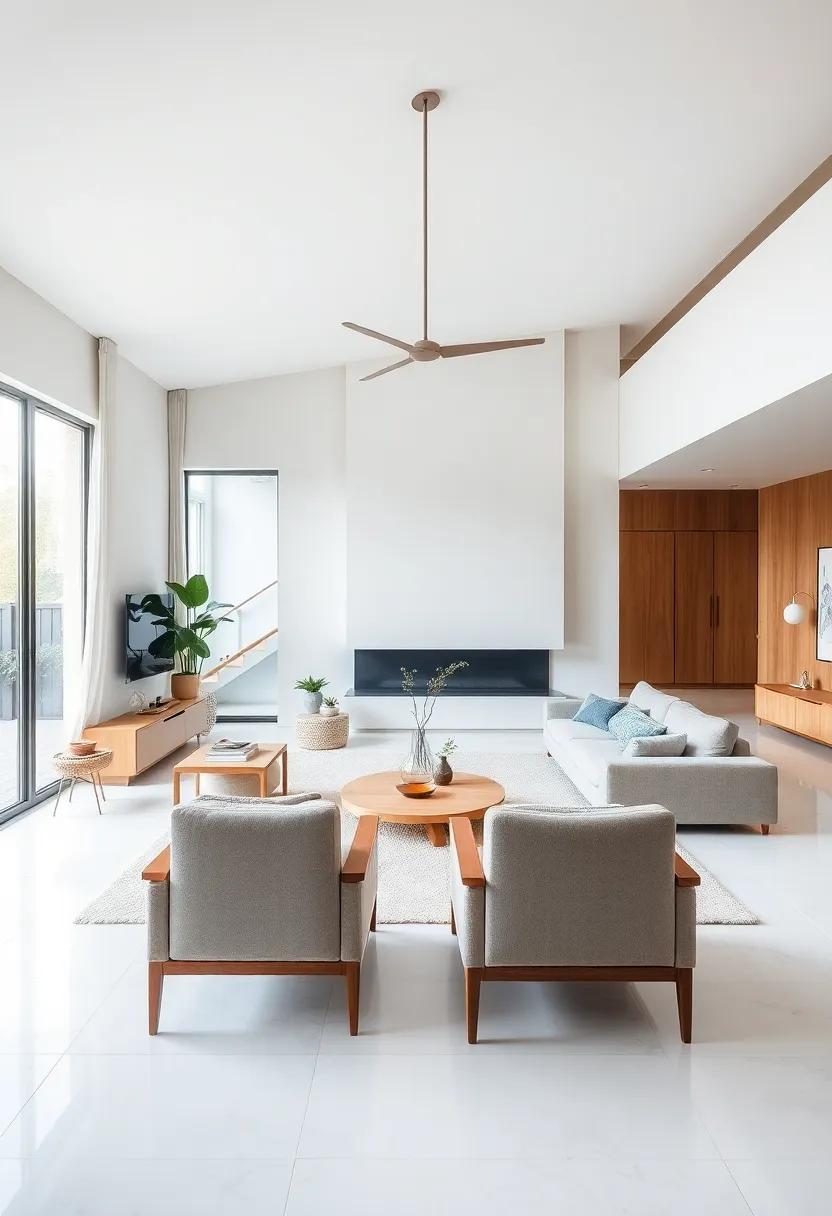
Creating a harmonious open floor plan requires careful attention to architectural details that facilitate seamless transitions between spaces.Crown molding, beamed ceilings, and notable archways can serve as elegant separators without disrupting the flow. These features not only add visual interest but also create a sense of continuity that enhances the overall design. By using a consistent palette of materials such as wood and stone, you can ensure that even though spaces are interconnected, they feel deliberately styled rather than chaotic.
When it comes to furnishings, selecting pieces that complement the overall design is key. Opt for multi-functional furniture that contributes to an airy feel, such as coffee tables with built-in storage or sofas that double as guest beds. consider incorporating a few strategic elements like a carefully placed area rug or floating shelves that guide the eye through the space. To illustrate how these ideas come together, below is a simple overview of essential components that create an effective open flow:
| Element | purpose |
|---|---|
| Crown molding | Adds elegance and defines space. |
| Beamed Ceilings | Creates warmth and character. |
| Area Rugs | Defines zones without walls. |
| Furniture with storage | Maximizes efficiency while minimizing clutter. |
Establishing a Focal Point for Balanced Visual Appeal
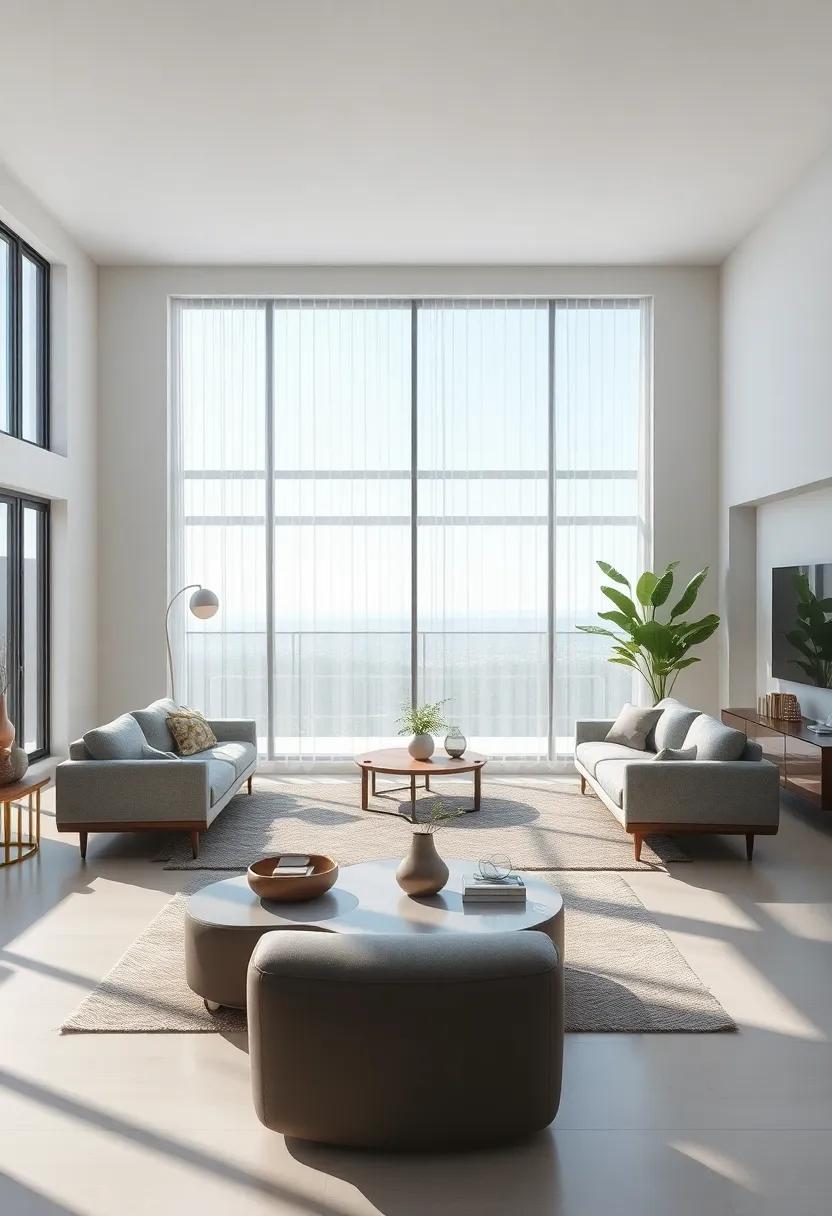
Creating a focal point in your Mid-Century living room is essential for achieving a cohesive and inviting atmosphere. Consider selecting a statement piece that draws the eye without overwhelming the space. Some excellent options include:
- A bold artwork that resonates with the color palette of your room
- A striking piece of furniture, such as a vintage coffee table or an oversized chair
- A fireplace, if available, that serves as a natural gathering spot
To ensure visual balance, the focal element should be complemented by surrounding décor that maintains harmony. Incorporate additional elements such as:
- Accent pillows that echo colors or patterns in the focal piece
- Plants that introduce organic shapes and textures without distracting from the main feature
- Lighting fixtures that enhance the focal point, providing both functionality and aesthetic appeal
Experimenting with Patterns to Add Depth and Character

In the world of mid-century design, patterns are your secret allies. They can breathe life into large open spaces, creating a visual rhythm that guides the eye throughout the room. Consider incorporating geometric designs, such as hexagons or bold stripes, on accent walls, rugs, or throw pillows. These elements can serve as focal points while maintaining the simplicity that characterizes mid-century aesthetics. Mixing retro florals with clean lines can also create a dynamic contrast that adds interest. When thoughtfully layered, these patterns respond beautifully to light, enhancing the overall ambiance of your living space.
To achieve a cohesive look, balance is key. Create a harmonious blend by choosing a color palette that ties your patterns together. Such as, a palette of muted yellows, deep teals, and soft grays can help unify various textures and motifs. Consider the following pairings:
| Pattern Type | Color Idea |
|---|---|
| Geometric | Soft Grey |
| Retro Floral | Muted Yellow |
| Abstract Waves | Deep Teal |
additionally, layering patterns in different materials can add depth and character. Such as, a plush velvet couch contrasted with linen or cotton pillows featuring complementary designs can enhance the tactile experience of your space. The interplay of various textures not only enriches the design but also invites guests to engage with the room intuitively. Don’t shy away from mixing tradition and modernity; this is where the true charm of mid-century design lies.
Creating Inviting Conversation Areas without Clutter
To create inviting conversation areas in a mid-century living room while maintaining an open floor plan, consider the balance between functionality and aesthetic appeal. Low-profile furniture allows for unobstructed views and an airy atmosphere, enriching the openness of your space. Focus on arranging seating in a way that encourages interaction.Use sofas and chairs that complement each other without overwhelming the area. to further enhance the feel, incorporate elements such as:
- natural textures – Wood, rattan, and linen fabrics bring warmth.
- accent lighting – Soft, adjustable lighting creates ambiance.
- Strategic accessories – Minimalist decor that adds personality.
Consider the layout of the space. A central coffee table can serve as a focal point in an open layout, drawing people together. Experiment with multiple seating arrangements that can easily adapt to gatherings; think of a pair of armchairs facing each other with a side table,fostering dialogue without the risk of clutter. Here’s a simple visual on how to layout your living area efficiently:
| Area | Suggested Arrangement |
|---|---|
| Living area | Sofa facing TV, side chairs angled towards each other |
| Conversation Nook | Two armchairs with a small table in between |
| Dining Zone | Round table to encourage inclusivity |
Using Color Blocking to Define Spaces within an Open Plan
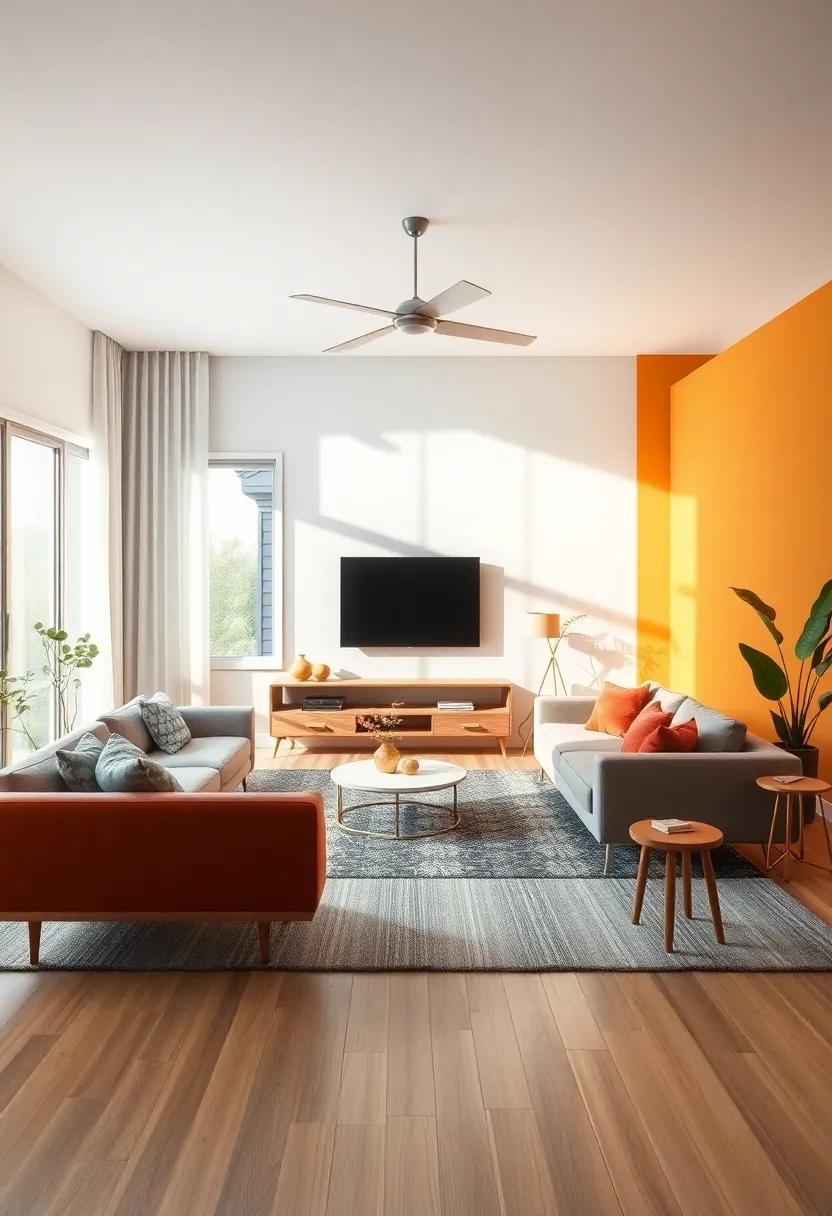
Color blocking is a powerful technique to visually segment areas in an open floor plan, allowing different functions to coexist harmoniously while still maintaining a cohesive aesthetic. By applying bold, contrasting colors to various zones, you can create distinctive atmospheres within a single space. As a notable example,using a vibrant blue for the living area and a soft mustard yellow in the reading nook can foster a sense of individuality for each area. Consider incorporating furniture pieces that feature these hues, such as sofas, armchairs, or even accent tables, which can effectively anchor the colors and define the boundaries of each space.
To maximize the impact of color blocking, think about the interplay of textures and patterns alongside the chosen colors. A simple list to guide your decor choices might include:
- Textured rugs: Layer a patterned area rug in the living space to add depth.
- Accent pillows: use pillows in complementary colors or bold patterns to tie back to the theme.
- Artwork: Hang pieces that reflect your color scheme, creating visual breaks between zones.
Additionally, consider accent walls or large pieces of furniture that can serve as visual dividers without obstructing sightlines. This approach not only helps to establish the character of each area but also invites creativity and personality into the overall design.
Inviting Personal History Through Vintage Finds and heirlooms
incorporating vintage finds and cherished heirlooms into your mid-century living room not only enhances its aesthetic but also weaves a rich tapestry of personal history into the space. When selecting pieces,consider items that reflect your family’s story or personal adventures,such as:
- Antique Furniture: A well-preserved armchair or a unique coffee table can serve as a focal point.
- Artworks: Vintage paintings or photographs that evoke nostalgia can add depth and character.
- Decorative Accessories: Items like an old globe or quirky ceramics can spark conversations and memories.
Transforming your living room into a gallery of personal history invites guests not just to admire aesthetics but to experience the essence of your journey. Consider creating a dedicated display area, where you can showcase heirlooms alongside curated vintage pieces to tell a compelling story. A simple design approach could involve:
| display idea | Description |
|---|---|
| Gallery Wall | Integrate framed vintage photos and art for a personal flair. |
| Curated Shelves | Use open shelving to showcase charming collectibles and books. |
| Accent Pieces | incorporate statement heirlooms, such as a grandfather clock or a cherished vase. |
Celebrating Simplicity with Minimalist Approaches and Designs
in the realm of interior design,a mid-century living room incorporates the beauty of open floor plans with minimalist principles. The focus shifts towards creating a harmonious space by allowing natural light to flow freely,emphasizing clean lines and functional furniture pieces that are both aesthetically pleasing and pragmatic. Essential elements include:
- Neutral Color Palettes: soft whites, warm beiges, and muted earth tones create a serene backdrop.
- Natural Textures: Integrating wood,stone,and linen adds depth and warmth without overwhelming the senses.
- Functional furniture: Mid-century furniture, characterized by its simple forms and organic shapes, pairs perfectly with an uncluttered space.
To reinforce the minimalist approach, consider utilizing multi-functional furniture that serves more than one purpose, like a sleek coffee table that doubles as a storage unit. Incorporating well-placed plants not only purifies the air but also invites a touch of nature into the space while maintaining simplicity. A sample layout for a mid-century-inspired room might include the following key features:
| Element | Description |
|---|---|
| Seating | Low-profile sofas with tapered legs for an airy feel. |
| Coffee Table | A round design in wood or glass to encourage conversation. |
| Accent Chair | An iconic Eames chair for a stylish focal point. |
| Lighting | A sleek floor lamp to illuminate without clutter. |
Capturing the Essence of Mid-Century Architecture in Modern Spaces
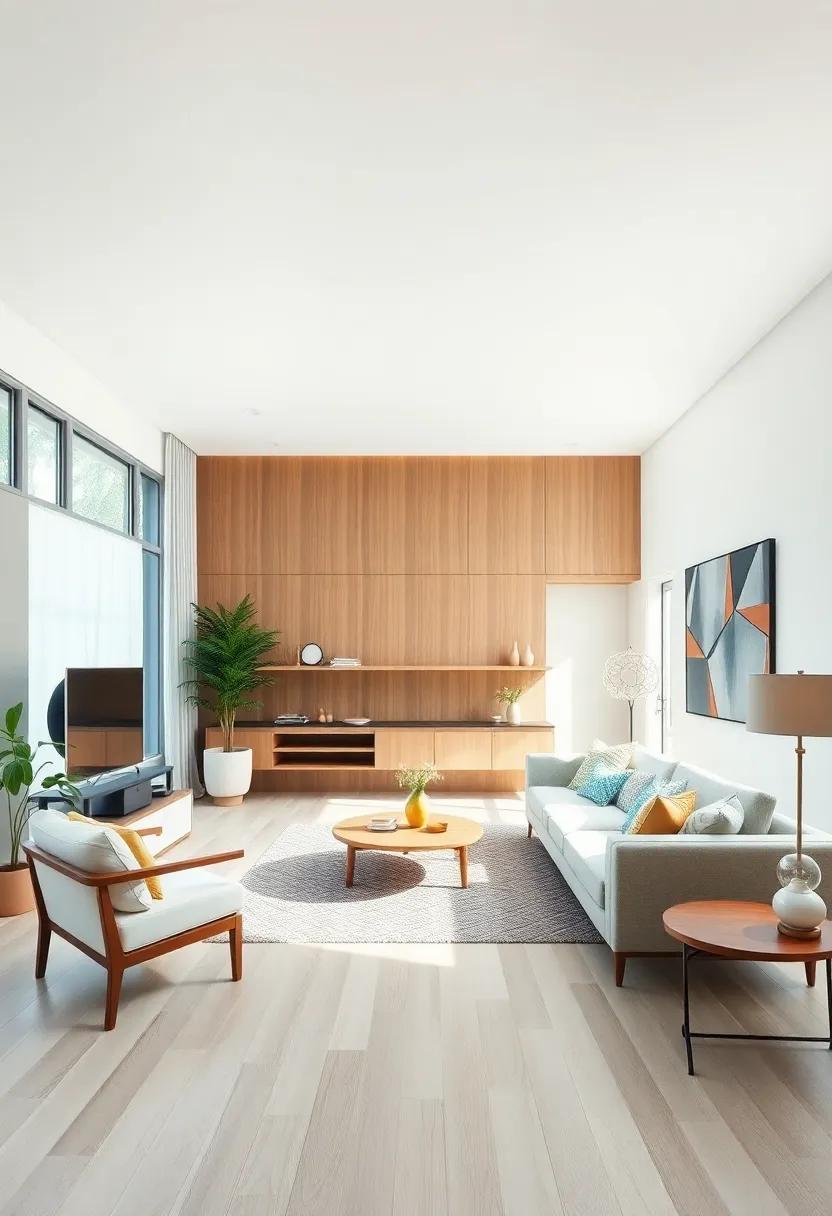
Embracing mid-century aesthetics within a modern context allows for a seamless blend of function and style. The hallmark of this design era lies in its clean lines and organic forms, which can be thoughtfully integrated into an open floor plan to create a cohesive living area. Key elements to consider include:
- Natural Materials: Incorporating wood, stone, and metal finishes establishes a grounding effect.
- Bold Color Palettes: Embrace vibrant hues, such as mustard yellow or olive green, that echo the vivacity of mid-century design.
- Iconic Furniture: Utilize statement pieces like Eames lounge chairs or a sleek, low-profile sofa to anchor the space.
Lighting also plays a crucial role in this design narrative. Consider ambient sources that reflect the era’s eclectic spirit, from sculptural pendant lamps to minimalist floor lamps that accentuate corners. Strategic placement encourages fluid movement and interaction within the space, reinforcing the openness desired in modern living. When curating art and decor, think about the following options:
| Art Style | Recommended Pieces |
|---|---|
| Abstract Expressionism | Canvas prints or bold sculptures |
| Geometric Patterns | Framed prints or decorative pillows |
By synthesizing these elements, the design not only pays homage to the mid-century ethos but also fosters a welcoming, functional, and timeless living space.
Enhancing Acoustic Quality Without Sacrificing Design
Balancing aesthetic appeal with functionality is crucial when designing a mid-century living room that embraces an open floor plan.To enhance acoustic quality, consider incorporating materials that can absorb sound without compromising on style. Options such as felt wall panels, luxury acoustic curtains, and woven materials can be strategically placed throughout the space to minimize echoes while contributing to the overall design theme. A few simple elements can make a noticeable difference:
- Rugs: Use plush rugs to create a soft underfoot layer that dampens noise.
- Artistic Dividers: Incorporate stylish room dividers that serve a dual purpose—style and sound absorption.
- Furniture Arrangement: Position furniture to create cozy nooks which can naturally reduce sound flow.
Another effective strategy is the use of sound-absorbing décor that complements the mid-century aesthetic. Consider integrating decorative items made of natural fibers, such as cotton or rattan, which add texture while silencing excess noise. A well-thought-out layout, infused with intentional design choices, enhances the living experience. Check out the table below for additional design elements that can definitely help achieve an exceptional acoustic environment:
| Design Element | Functionality |
|---|---|
| Felt Wall Panels | Reduce echo, stylish design |
| Acoustic Curtains | Block noise, enhance privacy |
| Textured Accessories | absorb sound, add visual interest |
Transforming Corners into Cozy Nooks for Relaxation
One of the most delightful aspects of a mid-century living room is the ability to transform underutilized corners into inviting corners for relaxation. Consider incorporating plush armchairs or a stylish chaise lounge to create a personal oasis. A cozy reading nook can be crafted with strategic placement of a small bookshelf and an ambient light source, such as a sleek floor lamp. To enhance the atmosphere,you might add a soft throw blanket and a few decorative cushions that resonate with the color palette of your space. The use of warm woods and muted palettes can connect these corners seamlessly with the overall mid-century design while offering a sense of retreat.
Accessories play a crucial role in creating these cozy nooks. Utilize a small side table to hold a cup of tea or a favorite novel, ensuring it complements the aesthetics of your mid-century furnishings. Consider adding elements like art plants or framed art pieces that speak to your personal style, infusing life and warmth into the area. Below is a simple table of key elements to consider for your corner change:
| Element | Purpose |
|---|---|
| plush armchair | Comfort and Style |
| Floor Lamp | Functionality and Ambiance |
| Small side Table | Convenience |
| Cushions & Throws | Textural Comfort |
| Art Plants | Liveliness |
Implementing Multi-Functional Furniture for Limitless possibilities
In an open floor plan, the integration of multi-functional furniture can dramatically enhance both the utility and aesthetic appeal of the living space. By selecting versatile pieces, you can maximize the potential of your environment. consider incorporating:
- Sofa beds that convert into sleeping spaces for guests, ensuring that functionality doesn’t compromise comfort.
- Ottomans that serve dual purposes as storage units or additional seating, helping to keep the area clutter-free.
- Expandable dining tables that can accommodate both intimate dinners and larger gatherings.
When strategically placed, these pieces can create zones within the open space, offering distinct areas for relaxation and socializing without the need for physical barriers. Multi-functional furniture not only saves space but also promotes a fluid design that encourages movement and interaction. To exemplify this harmony, consider the layout below:
| Furniture Item | Functionality | Styling Tip |
|---|---|---|
| Sofa Bed | Seating & Sleeping | choose neutral tones for versatility. |
| Storage Ottoman | Seating & Storage | Use patterned fabric for visual interest. |
| Expandable Table | Dining & Work | Add a centerpiece for elegance. |
Future Outlook
In the world of interior design, the trends may shift like the tides, but the essence of a space—its ability to foster connection and comfort—remains timeless. As we conclude our exploration of crafting a mid-century living room within an open floor plan, it’s clear that embracing space is not merely about aesthetics; it’s about creating an environment that resonates with the rhythms of everyday life.
The elegant simplicity of mid-century design invites us to celebrate both form and function, marrying clean lines with organic touches to curate a harmonious atmosphere.With careful consideration of layout, furnishings, and accents, you have the possibility to design a sanctuary that reflects your personal style while promoting a seamless flow between spaces.
As you embark on this design journey, remember that every corner holds potential. Allow your creativity to take flight, honoring the past while inviting in the present. The result will be more than just a living room; it will be a vibrant hub where memories are made and shared, a true embodiment of the open-hearted spirit of mid-century modernism. here’s to a home that welcomes both space and soul, inviting all who enter to pause, breathe, and be present.
 efistu.com Home Decor
efistu.com Home Decor
